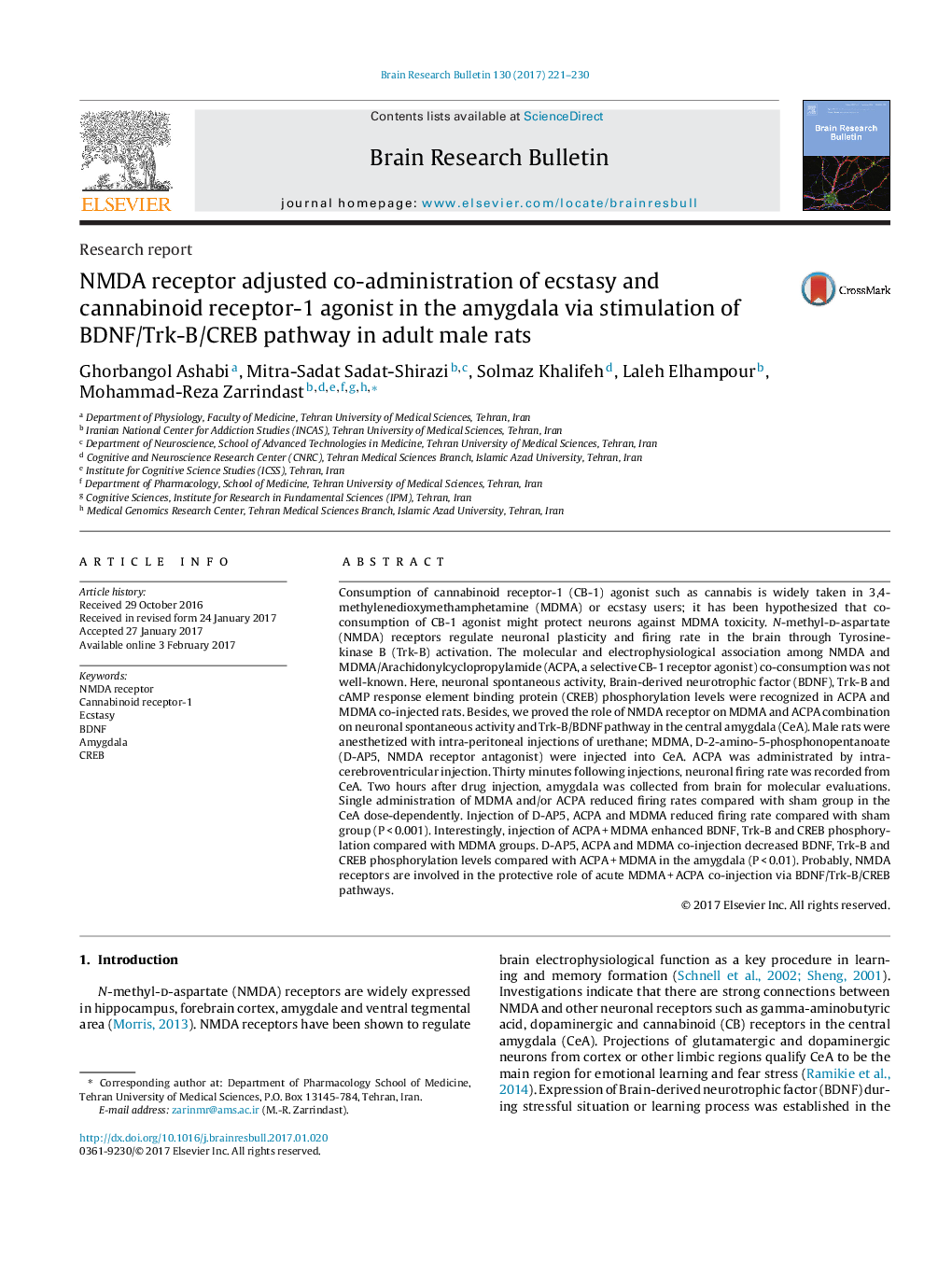| کد مقاله | کد نشریه | سال انتشار | مقاله انگلیسی | نسخه تمام متن |
|---|---|---|---|---|
| 5736381 | 1613227 | 2017 | 10 صفحه PDF | دانلود رایگان |

- Injection of MDMA and CB-1 receptor agonist reduced neuronal spontaneous discharging.
- NMDA blockade reduced neuronal firing rate and Trk-B/BDNF/CREB level in MDMA and CB1 receptor agonist co-injected rats.
- Glutamatergic system regulates the protective role of MDMA and ACPA combination via Trk-B receptors.
Consumption of cannabinoid receptor-1 (CB-1) agonist such as cannabis is widely taken in 3,4- methylenedioxymethamphetamine (MDMA) or ecstasy users; it has been hypothesized that co-consumption of CB-1 agonist might protect neurons against MDMA toxicity. N-methyl-d-aspartate (NMDA) receptors regulate neuronal plasticity and firing rate in the brain through Tyrosine-kinase B (Trk-B) activation. The molecular and electrophysiological association among NMDA and MDMA/Arachidonylcyclopropylamide (ACPA, a selective CB-1 receptor agonist) co-consumption was not well-known. Here, neuronal spontaneous activity, Brain-derived neurotrophic factor (BDNF), Trk-B and cAMP response element binding protein (CREB) phosphorylation levels were recognized in ACPA and MDMA co-injected rats. Besides, we proved the role of NMDA receptor on MDMA and ACPA combination on neuronal spontaneous activity and Trk-B/BDNF pathway in the central amygdala (CeA). Male rats were anesthetized with intra-peritoneal injections of urethane; MDMA, D-2-amino-5-phosphonopentanoate (D-AP5, NMDA receptor antagonist) were injected into CeA. ACPA was administrated by intra-cerebroventricular injection. Thirty minutes following injections, neuronal firing rate was recorded from CeA. Two hours after drug injection, amygdala was collected from brain for molecular evaluations. Single administration of MDMA and/or ACPA reduced firing rates compared with sham group in the CeA dose-dependently. Injection of D-AP5, ACPA and MDMA reduced firing rate compared with sham group (PÂ <Â 0.001). Interestingly, injection of ACPAÂ +Â MDMA enhanced BDNF, Trk-B and CREB phosphorylation compared with MDMA groups. D-AP5, ACPA and MDMA co-injection decreased BDNF, Trk-B and CREB phosphorylation levels compared with ACPAÂ +Â MDMA in the amygdala (PÂ <Â 0.01). Probably, NMDA receptors are involved in the protective role of acute MDMAÂ +Â ACPA co-injection via BDNF/Trk-B/CREB pathways.
CB1 receptor activation or MDMA induction reduced neuronal firing rate. Simultaneous injection of these two drugs enhanced neuronal cell survival, and these events were reversed via NMDA receptors antagonist. Probably, protective role of glutamatergic receptors might be through activation of BDNF/Trk-B pathways. The figure created from www.mindthegraph.com.172
Journal: Brain Research Bulletin - Volume 130, April 2017, Pages 221-230